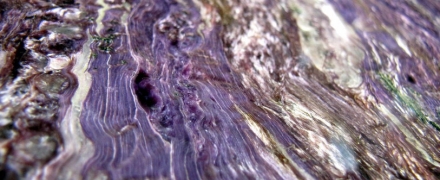open 10 am - 7 pm
laboratory is closed
Interesting minerals of charoite rocks

We all know that the patterned textures in decorative charoitites are very diverse and can sometimes reproduce landscapes, individual figures, and even faces. However, we want to talk not about the patterned varieties of this decorative rock, but about the minerals found in it, which are embodied in their names by the names of prominent scientists, geologists, mineralogists and simply connoisseurs and lovers of stone. The first mineral is aggrellite. The mineral found in the charoitite as an accessory, but nevertheless, on an equal footing with other charoitite minerals, reflects the entire mineral wealth of this extraordinary rock. The mineral agrellite was named in 1973 after the English mineralogist Stuart Olof Agrell (1913-1996), and the first information about it was published in the Canadian Mineralogist magazine in 1976 by John Gittins, Michael Bone ( Michael G. Bown and Bozidar Darko Sturman (1937-2019). Stuart Agrell is famous for being co-founded by Jim W.P. Long (Jim V.P. Long, 1926-2003) in 1949 began to use an electron microscope for mineralogical and petrological research. Another field that brought Stuart Agrell worldwide fame was the study of meteorite mineralogy. In 1949 he began to study the mineralogy of meteorites on the basis of the collection of the University of Cambridge. As a result, he devoted his entire life to the problems of meteorite mineralogy, moreover, becoming the only non-American researcher of lunar rock samples collected as a result of the Appolo program. The mineral aggrellite belongs to the class of inosilicates (chain and tape silicates) and has the chemical formula - NaCa2 (Si4O10) F.
В геммологической практике бывают весьма увлекательные случаи с диагностикой ювелирных вставок
Но помимо редкости цвета и высокой стоимости таких камней, многие розовые камни выделяются одной замечательной особенностью – они проявляют плеохроизм, то есть в зависимости от положения осмотра камня он может иметь дополнительные оттенки – оранжевый или пурпурный.
Currently, gemstones are produced by two fundamentally different technological methods - the High Pressure - High Temperature method (“HPHT”, High-pressure & High-temperature) and the Chemical Vapor Deposition (“CVD”, Chemical vapor deposition) method. The "HPHT" method is the most tested classical synthesis method, which can be used both carbon deposition on diamond from flux melts and catalytic reactions. In "CVD" synthesis, diamond growth occurs on a seed during carbon deposition mainly from a gaseous medium at relatively low temperatures and pressures.
Jewelry and precious stones are just such a category of goods, when buying which you need to pay attention to many criteria.
Sogdianite is a rather rare mineral and more often it can be found as a collection material (moreover, in systematic collections), and it is extremely rare in jewelry.






